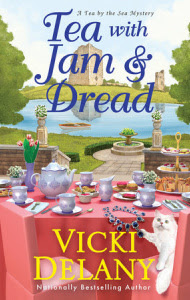Though chocolates express love as a Valentine’s or Mother’s Day gift, they’ve been associated with death in history and mystery. Two hundred years ago chocolate was something you drank, but by the mid-19th century, confectioners had devised ways to create solid chocolate. As truffles and chocolate creams became popular treats, their potential as vehicles for poison became obvious. Previously, poisoners had to be near a victim's food or drink to accomplish their goals. But poisoned chocolates could be delivered anonymously. Who can resist a box of chocolates from a secret friend or admirer? We don’t know how many murderers got away with using chocolates laced with poison, but here are two famous ones who were caught.
Christiana Edmunds, the "Chocolate Cream Killer,” was a serial poisoner in Brighton, England, during the early 1870s. She bought chocolate creams, injected them with strychnine, and returned them to the vendors, who then sold them to others without knowing they were poisoned. She even sent herself a box of poisoned chocolates to suggest she was also a victim.
On this side of the Atlantic in 1898, Cordelia Botkin mailed a box of arsenic-laced chocolates from San Francisco to her ex-lover’s wife in Dover, Delaware. The transcontinental crime was the earliest known use of the U.S. Mail for nefarious purposes. Bodkin was the first person prosecuted for a crime that took place in two different U.S. jurisdictions.
Inspired by true crime, mystery
writers built plots around similar poisonings. In Anthony Berkeley’s 1929 mystery, The Poisoned
Chocolates Case, six armchair detectives tackle the case of a woman who died
after eating liqueur-filled chocolates. Each comes up with a different theory
and a murderer no one else has considered. Agatha Christie also explored
chocolate as a weapon in Peril at End House and in “The Chocolate Box,” a story
in which Poirot chides himself for missing the key clue.
In my 7th Five-Ingredient Mystery, Gingerdead Man, a murderer acts like the neighborhood’s Secret Santa, leaving holiday gift bags of chocolates on doorsteps. When an elderly victim appears to die of natural causes, the police don’t suspect the chocolates because there’s no sign of tampering. But my sleuth Val recognizes them as homemade. She convinces the police to test the chocolates by describing how easy it is to make chocolates at home. No need to inject a poison in them if it’s mixed into the filling.
Would you prefer a box of chocolates or a bouquet of flowers as a gift?
Have you read any mysteries with poisoned chocolates in them?
📚📚
Maya Corrigan writes the Five-Ingredient Mysteries featuring café manager Val and her live-wire grandfather solving murders in a Chesapeake Bay town. Maya lives in a Virginia suburb of Washington, D.C. Before writing crime fiction, she taught American literature, writing, and detective fiction at Northern Virginia Community College and Georgetown University. When not reading and writing, she enjoys theater, travel, trivia, cooking, and crosswords. Visit her website for easy recipes, mystery history and trivia, and a free culinary mystery story.









































I love this history!
ReplyDeleteThank you, Edith.
DeleteInteresting article, Maya!
ReplyDeleteI read most of Berkley's mysteries and remember reading The Poisoned Chocolates Case in the 1980s.
Recently, I have read Amber Royer's Bean-to-Bar mysteries. Felicity Koerber owns a bean-to-bar chocolate factory in Galveston TX. Lots of interesting details on how the cacao is transformed into yummy chocolate.
Thank you for suggesting the Bean-to-Bar mysteries. They sound delicious!
DeleteFascinating history, MaryAnn! Thank you.
ReplyDeleteI love and eat dark chocolate, every day. Everyone who knows me knows this, so we get lots of chocolate gifts, especially around the holidays. But the truth is, I prefer my dark chocolate straight, with no fillings, just high quality over-70% cocao. The fancy stuff, yummy as it is, is wasted on me.
As a lifelong chocoholic, I found this history very interesting! I hated learning that chocolate at the hands of a skilled poisoner can be fatal, but this does not diminish my love for the dark variety. Chocolate is the answer, no matter what the question!
ReplyDeleteFabulous history info, Maya! I've read so many books involving the poisoned chocolates I couldn't begin to name them. Doesn't deter me from indulging in a favorite treat!
ReplyDeletePoisoned chocolates seem to be a staple in the mystery writer's pantry. Thanks for your comment, Lynn.
DeleteDark chocolate, although flowers ARE nice.
ReplyDeleteLike Karen, Fran, and Libby, I am a dark chocolate fan! Thanks for commenting.
ReplyDeleteGreat and interesting history of chocolates and poison! As for me, I'd prefer the flowers. They would sure last longer. LOL
ReplyDelete2clowns at arkansas dot net
:-) The flowers definitely last longer in my house too! Thanks for commenting, Kay.
Delete